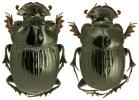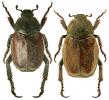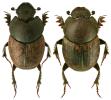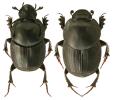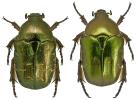Images:
The largest family within Scarabaeoidea, Scarabaeidae has 83 British representatives in six subfamilies, and includes the chafers, scarab beetles and the majority of the dung beetles. Small to large species (3-20mm), most are powerfully built beetles with fossorial legs and some can swarm in large numbers.
Subfamily Aegialiinae has three British species, all small (4-5mm), elongate and associated with decaying vegetation in dry, sandy areas. Psammoporus sabuleti (Panzer) is a local species of sandy river banks: both Aegialia species are locally-distributed maritime beetles.
Aphodiinae is the largest subfamily with 55 species, the majority of which are dung beetles in the genus Aphodius. Built like scaled-down Geotrupidae, Aphodiinae very rarely excavate tunnels and larvae are instead found in surface dung or decaying vegetable matter. Adults generally have a smooth, black, rounded pronotum and black, brown or red striate elytra.
The subfamily Aphodiinae also includes two introduced species of Saprosites, S. mendax (Blackburn) and S. natalensis (Peringuey) which are often elevated to subfamily level as the Eupariinae. These are 3mm shining black species with strongly punctured striate elytra and red appendages, found under bark or from the burrows of Lucanidae species. Tribe Psammodiini is also often elevated to subfamily level: of these, Brindalus porcicollis (Illiger) is extinct in Britain, Pleurophorus caesus (Creutzer) and Rhyssemus germanus (L.) are known from old records, and the remaining four species - Diastichus vulneratus (Sturm), Psammodius asper (Fabricius), Tesarius caelatus (LeConte) and T. mcclayi (Cartwright) – are rare or very local. Small (2.5-4.5mm) beetles, they have obviously-ridged pronotums.
Subfamily Scarabaeinae includes nine British species, eight 4-11mm Onthophagus species and the probably-extinct Copris lunaris L. (14-20mm). Primarily associated with dung, these species can also be found in carrion and rotting fungi. They are black beetles, some species with paler elytra, and dig vertical burrows beneath dung.
The subfamily Melolonthinae are chafers, rather than dung beetles, and larvae of the eight British species can be found feeding on plant roots while the large brown adults fly strongly, often coming to light. Polyphylla fullo (L.) is included on the British list but is thought to be largely adventitious. The large brown chafer Melolontha melolontha (L.) (cockchafer or maybug) is a member of this subfamily and can occasionally swarm in large numbers.
Rutelinae is a small subfamily, with just two British representatives. Both have a bottle-green metallic pronotum and brown elytra: Anomala dubia (Scopoli) is a local, coastal species mainly found in the south, while Phyllopertha horticola (L.) is widespread and often common, particularly in the south.
Cetoniinae (including the tribe Trichiini, often promoted to family level) has six British members, mostly bright metallic species although Trichius fasciatus (L.) is a black and yellow bee mimic. None are particularly common: the most widespread is probably the rose chafer Cetonia aurata (L.) which can be found visiting flowers, particularly in southern England.








